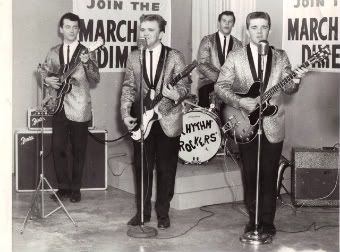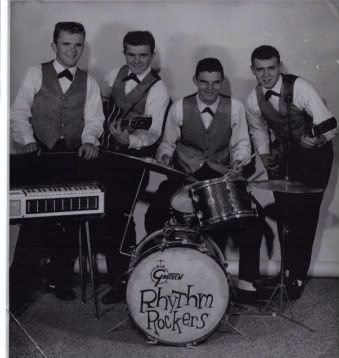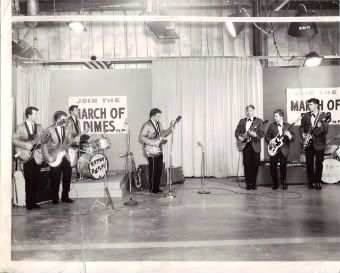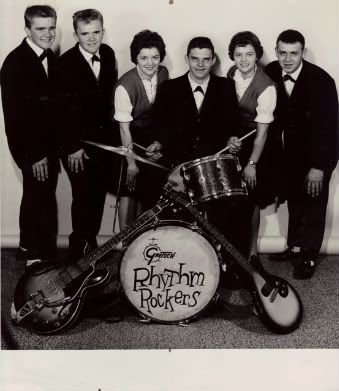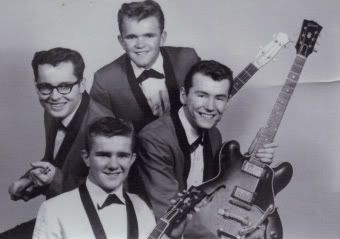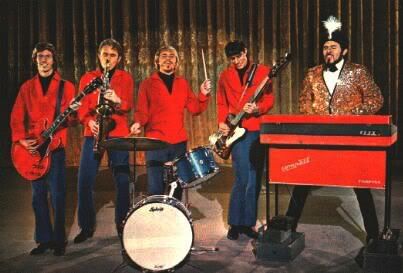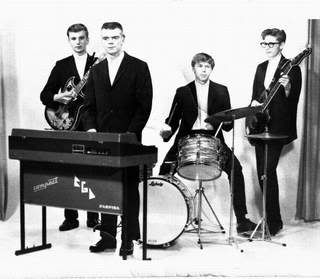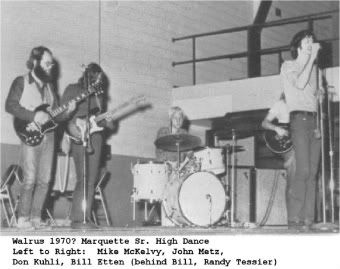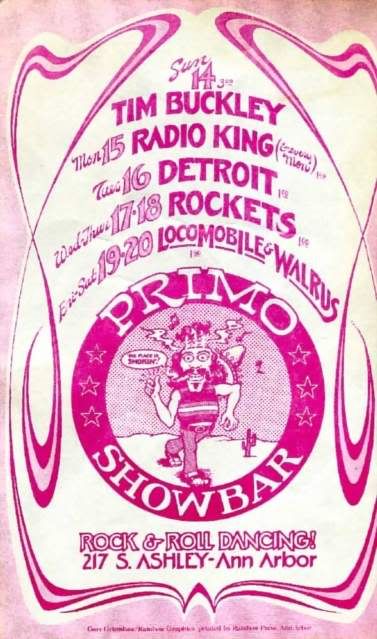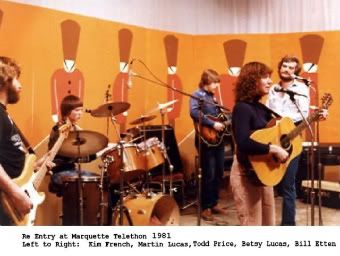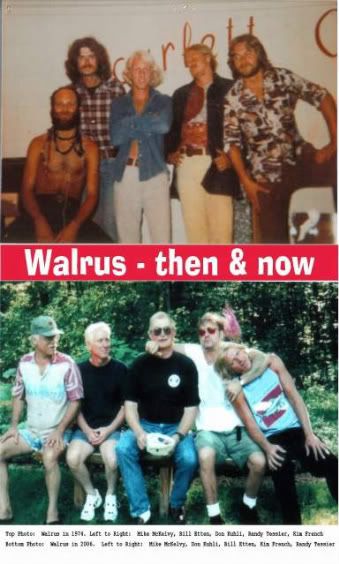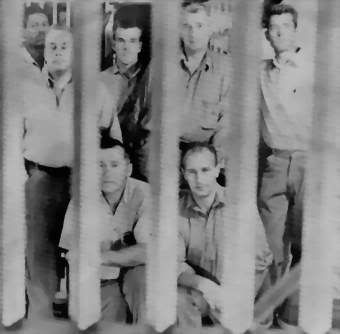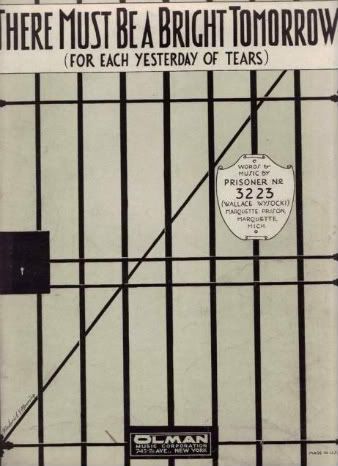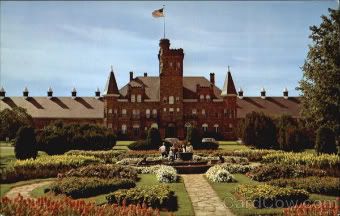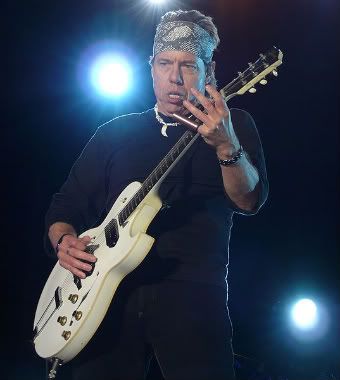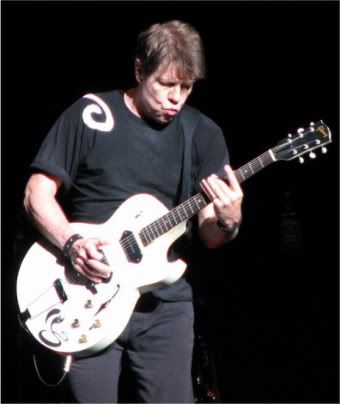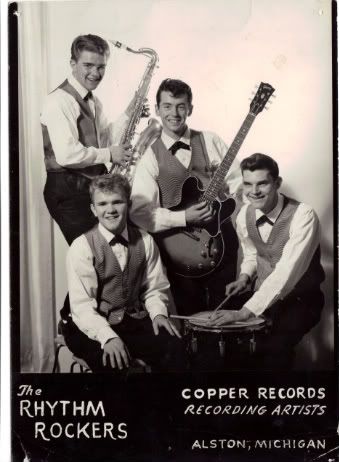
This promotional photo of the Rhythm Rockers
was taken at DeMott's Photo Studio in Hancock. Clockwise
from top are Dick Patana, Mike Kadletz, Jerry Tahatinen
and John Patana.
By STEVE SEYMOUR
The Upper Peninsula's Rhythm Rockers issued 45 rpm records and performed hundreds of shows during a career which lasted more than a quarter century.
Formed in 1958, the original Rhythm Rockers were Richard "Dick" Patana (sax, guitar, vocals), brother John Patana (bass, keyboard, accordion, vocals), Tom Hiltunen (guitar) and Jerry Tahatinen (drums).
The four musicians were teenage friends in the tiny Copper Country community of Alston, 13 miles west of Baraga.
One of their earliest performances took place at a dance at a roller rink in Ontonagon, and the band's reputation grew as they played throughout Michigan and neighboring Wisconsin.
Their recording activities culminated in the early 1960s, when both their singles were released on their own Copper label.
For their first foray into the studio, the Rhythm Rockers traveled to Lansing to tape "Count Down" and "Unchained Melody."
Written by Alex North and Hy Zaret, "Unchained Melody" was one of the most popular songs of the 20th century, spawning over 500 versions. Les Baxter took the song to the top of the pop singles chart in 1955, while the Righteous Brothers released their hit version in 1965.
"Unchained Melody" was chosen to record because it was the most popular slow song in the Rhythm Rockers' repertoire, John Patana told me.
Their take was paired with "Count Down," an original tune composed by Dick Patana. That song is a lively surf instrumental, recalling the Ventures.
The Rhythm Rockers ordered 5,000 copies of "Unchained Melody" which they sold to band patrons between sets for $1 each. John Patana said he worked hard to sell the single during band breaks because each member got to pocket the money from the copies he sold.
To publicize the record, the band had a promotional picture taken at DeMott's Photo Studio in Hancock. The photos were inscribed with the words: "Copper Records Recording Artists." Labels for their records were customized with the drawing of a copper ingot.
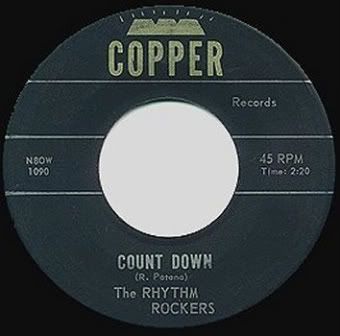
The band dispatched many copies of "Unchained Melody" during the summer of 1961 when they served as the house band at the Forest Inn in Munising.
During this period, teenager Mike Kadletz (guitar, vocals) joined the band as a replacement for Hiltunen, while Larry Sabourin assumed the drummer's position when Tahatinen took a job with United Parcel Service.
In December, 1962, the band traveled to Cuca Record Corp., located in Sauk City, Wisconsin, armed with two more songs written by Patana. "Bad News" was a rockin' number with vocals, which related the school and car troubles of a teenager anticipating a date on Saturday night with a "really sharp chick."
The flipside was sax-powered instrumental called "Twilight."
Both songs were taped by Cuca owner James E. Kirchstein, who also published the tunes. For the 45 rpm single, the pairing was given catalog number C-1006. The band ordered 2,500 copies to sell at gigs, John Patana recalled.
"Bad News," a catchy track reminiscent of Eddie Cochran's "Summertime Blues," was released on compact disc in 2006. The track appears on "Cuca Records Story, Vol. 3, Rockin' in Wisconsin," issued by England's Ace Records. The CD package includes an often- informative booklet by writer Rob Finnis, who admitted he knew little about the Rhythm Rockers, or even who was in the group.
The Rhythm Rockers also recorded "Lonely Lover" at the Cuca studio, but that song wasn't released.
Although they occasionally surface on eBay, the two Rhythm Rockers 7-inch singles are now hard to find.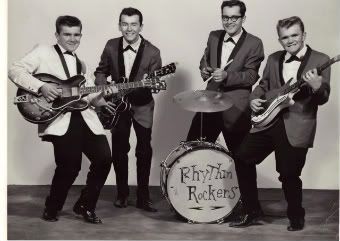
The Rhythm Rockers were one of the most popular
bands in the Upper Peninsula for decades. From left are
Dick Patana, Mike Kadletz, Larry Sabourin and John Patana.
Early in their career the Rhythm Rockers were able to boast two 45s as the group booked engagements around the region. The band presumably played live versions of their recordings when they entertained at the Senior Ball at Escanaba Area High School on April 26, 1963.
The Rhythm Rockers played another memorable prom in 1963 at Rapid River High School where John Patana met Brenda Moser. They were married in 1964.
Group leader Dick Patana once estimated the Rhythm Rockers played at almost 400 different venues over the years. They appeared often on the March of Dimes telethon broadcast live by WLUC-TV6 in Marquette. 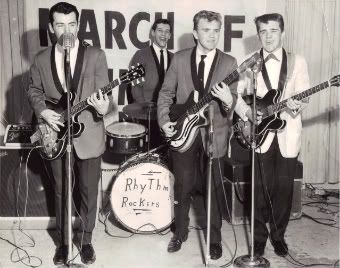
The band maintained a professional look, always appearing for engagements in custom jackets made in New York City, Brenda Patana recalled.
At their peak, the group commanded $1,500 per night, and were household names throughout the Upper Peninsula. At one point they were booked for a year and one half in advance.
In Escanaba, the Rhythm Rockers played teen dances at Teamsters Hall, and were often the featured entertainment at Skinny's Bar. They were also regularly booked into Bill's Bar and the Swallow Inn, competing bars in Rapid River.
Escanaba radio stations WDBC and WLST added the Rhythm Rockers' singles to their playlists due to strong local demand.
Playing whatever people wanted to hear, from polkas to pop, the Rhythm Rockers were a popular choice for wedding receptions throughout the Upper Peninsula.
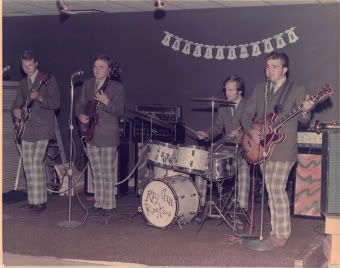
Through the years, they were joined by Jack Rogers; Mark Pyykkonen; Tom Kemp; brothers Hank and Dale Mroczkowski; and Brenda Patana, who sang pop, rock and country songs.
During their career, the Rhythm Rockers played back-up for Conway Twitty, famous for "It's Only Make Believe," and shared the stage with Stonewall Jackson, who recorded the top country hit, "Waterloo."
The U. P. combo took the Rhythm Rockers name after they saw it in Hit Parader magazine. It was a catchy moniker, easier to say than write. Many people, including school superintendents, couldn't spell it, John Patana said.
At least ten other acts recorded under the same name, according to music historian Gary E. Myers.
Although the U. P.'s Rhythm Rockers disbanded in the mid-1980s, they staged several reunions, including one at the Swallow Inn in 1987 and another in L'Anse in 1996.
Dick Patana carried on with other musical groups including the Weekend Cowboy Band. He also performed as a solo artist for many years.
In 2001, Patana won an Elvis Presley sound-alike contest in Florida and was awarded a recording session at M & M Studios in Spring Hill, Florida. There, he recorded a full-length album with studio musicians called "Doin' My Thing, Vol. 1."
The 12-track compact disc included some of Patana's favorite songs: Freddy Fender's "Before the Next Teardrop Falls;" Louis Armstrong's "What a Wonderful World," and Roy Orbison's 1960 smash, "Only the Lonely." In "To All the Girls I've Loved Before," Patana imitated the voices of Julio Iglesias, Willie Nelson, Elvis, cartoon character Elmer Fudd and Mr. Ed, television's talking horse.
Tragically, Dick Patana died in a traffic accident just two years later at age 62. The fatal mishap occurred on Sept. 8, 2003 on Highway U.S. 41 near Alberta in Baraga County. Patana's wife, Sandra was seriously injured. The Patanas had spent their winters in Florida, but returned to Houghton for the summer months.
Two members of the Rhythm Rockers, John Patana and Mike Kadletz, both reside in the Rapid River area and remain close friends. Kadletz performed with the Full Circle Band last year, while Patana has appeared at Rapid River High School talent contests.
Today, the Rhythm Rockers still evoke powerful memories from many people, including Clark Sullivan, lead singer of the Excels, a Marquette-based rock band which released five 45 rpm singles in the 1960s and toured the midwest extensively.
"If there was any group in the Upper Peninsula that stood out, in my opinion, and affected me the most, it was the Rhythm Rockers," said Sullivan, who has also recorded as a solo artist.
"Dick and John (Patana) became good friends and I respect what they accomplished. When I started in music, this was the group I wanted to emulate," he added.
"I remember seeing them when I was in high school and being completely blown away. Where most groups had just a lead singer with no harmonies, the Rhythm Rockers had three and four-part harmony. They could play and sing just about anything."
Rhythm Rockers Photo Gallery